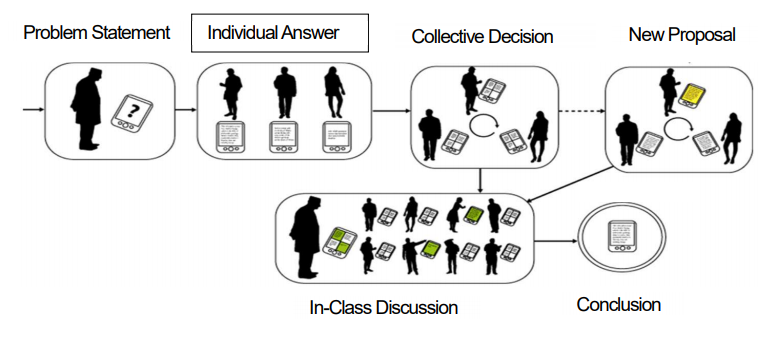
Collaborative Learning is a powerful study strategy where students work in teams to share knowledge, solve problems, and achieve learning goals.
It is particularly effective in environments requiring deep understanding or creative thinking. Discover how to maximize study efficiency and enjoy learning with Collaborative Learning, as recommended by StudyDuck!
1. What is Collaborative Learning?
Collaborative Learning involves two or more learners forming a team to engage in interactive studying. Rather than passively receiving knowledge, learners deepen their understanding through discussions, problem-solving, and exchanging feedback.
- Features
- Active communication among learners
- Enhanced responsibility through role division
- Approaching problems from diverse perspectives
- Benefits
- Deeper understanding and long-term retention
- Improved critical thinking and teamwork skills
- Increased motivation for learning
2. Key Elements of Collaborative Learning
To ensure effective collaborative learning, consider the following elements:
- Clear Goal Setting: Define the group’s objectives (e.g., mastering a topic, preparing for an exam).
- Optimal Group Size: A small group of 3–5 members is ideal to maintain focus and engagement.
- Role Division: Assign roles such as presenter, note-taker, or timekeeper to boost participation.
- Structured Activities: Plan clear activities like discussions, problem-solving, or quizzes.
3. How to Implement Collaborative Learning
Step 1: Form a Study Group
- Gather peers with similar learning goals (e.g., standardized test prep, certification studies).
- Choose members whose personalities and study styles complement each other.
Step 2: Create a Study Plan
- Set weekly goals and detailed schedules. For example, Mondays for concept review, Wednesdays for practice problems.
- Prepare an online (Zoom, Google Meet) or offline study environment.
Step 3: Execute Activities
- Discussion-Based Learning: Have each member present prepared material and engage in Q&A to deepen understanding.
- Problem-Solving Tasks: Work together to solve past exam questions or analyze case studies.
- Feedback Sessions: Share strengths and areas for improvement after each session.
Step 4: Evaluate Results
- Assess whether learning goals were met and evaluate the group’s effectiveness.
- Adjust study methods or group composition as needed.
4. Tips and Precautions for Collaborative Learning
- Tips
- Maintain consistency with regular meetings (1–2 times per week).
- Use digital tools (Trello, Notion) to share resources and schedules.
- Foster a positive atmosphere by encouraging each other.
- Precautions
- Prevent domination by one member or passive participation by rotating roles.
- Avoid time-wasting by setting time limits for discussions (e.g., 15 minutes per topic).
5. Real-Life Examples of Collaborative Learning
- Standardized Test Prep Group: Four high school seniors met weekly to solve math practice questions, explaining mistakes and sharing error notes, resulting in an average score increase of over 10 points.
- University Project Team: Three college students divided research tasks for a project, holding weekly discussions to integrate findings, earning high grades and improved teamwork skills.
Collaborative Learning offers more than just studying—it boosts motivation, exposes you to diverse perspectives, and builds teamwork skills.
StudyDuck supports you in mastering both the joy and efficiency of learning through collaborative methods!
Start forming your study group today and take the first step toward success!
"Efficient learning tailored to your learning style, with Study Duck!"
By applying customized learning methods based on your MBTI, your learning effect doubles!
While you can learn quickly on your own, Study Duck helps you stay consistent and learn in the long term.
Stay focused with the study timer and maintain consistency by competing with others on the leaderboard.
Open a new chapter of learning with Study Duck now!
Study Duck - Smart Learning Assistant
Enhance your study efficiency with personalized MBTI learning strategies, focus mode, and white noise.
studyduck.net

'학습법' 카테고리의 다른 글
| ラバーダックデバッグ学習法:すべての学習者のための効果的な問題解決の秘訣 (0) | 2025.04.17 |
|---|---|
| Rubber Duck Debugging 학습법: 모든 학습자를 위한 효과적인 문제 해결 비법 (0) | 2025.04.17 |
| 協同学習法で学習効率を2倍にする方法 | スタディダック学習ガイド (0) | 2025.04.16 |
| 협력 학습법으로 공부 효율 2배 높이는 방법 | 스터디덕 학습 가이드 (0) | 2025.04.16 |
| 英語の筆記体を完全マスター:なぜ筆記体を学ぶべき? (0) | 2025.04.15 |



